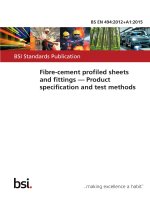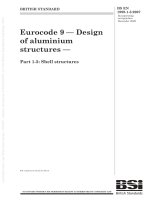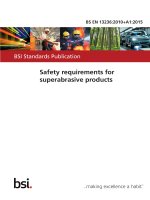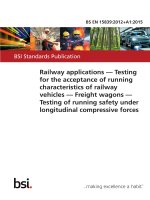Bsi bs en 62325 451 5 2015
Bạn đang xem bản rút gọn của tài liệu. Xem và tải ngay bản đầy đủ của tài liệu tại đây (1.62 MB, 54 trang )
BS EN 62325-451-5:2015
BSI Standards Publication
Framework for energy
market communications
Part 451-5: Problem statement and
status request business processes,
contextual and assembly models for
European market
BRITISH STANDARD
BS EN 62325-451-5:2015
National foreword
This British Standard is the UK implementation of EN 62325-451-5:2015. It
is identical to IEC 62325-451-5:2015.
The UK participation in its preparation was entrusted to Technical
Committee PEL/57, Power systems management and associated
information exchange.
A list of organizations represented on this committee can be obtained on
request to its secretary.
This publication does not purport to include all the necessary provisions of
a contract. Users are responsible for its correct application.
© The British Standards Institution 2015.
Published by BSI Standards Limited 2015
ISBN 978 0 580 85016 5
ICS 33.200
Compliance with a British Standard cannot confer immunity from
legal obligations.
This British Standard was published under the authority of the
Standards Policy and Strategy Committee on 30 April 2015.
Amendments/corrigenda issued since publication
Date
Text affected
BS EN 62325-451-5:2015
EUROPEAN STANDARD
EN 62325-451-5
NORME EUROPÉENNE
EUROPÄISCHE NORM
April 2015
ICS 33.200
English Version
Framework for energy market communications - Part 451-5:
Problem statement and status request business processes,
contextual and assembly models for European market
(IEC 62325-451-5:2015)
Cadre pour les communications pour le marché de l'énergie
- Partie 451-5: Processus métier d'énoncé de problème et
de demande de position, modèles contextuels et modèles
d'assemblage pour le marché européen
(IEC 62325-451-5:2015)
Kommunikation im Energiemarkt - Teil 451-5:
Problemstellungs- und Status-AnfragenGeschäftsprozesse, kontextbezogene Modelle und
Einbindungsmodelle für den europäischen Markt
(IEC 62325-451-5:2015)
This European Standard was approved by CENELEC on 2015-03-24. CENELEC members are bound to comply with the CEN/CENELEC
Internal Regulations which stipulate the conditions for giving this European Standard the status of a national standard without any alteration.
Up-to-date lists and bibliographical references concerning such national standards may be obtained on application to the CEN-CENELEC
Management Centre or to any CENELEC member.
This European Standard exists in three official versions (English, French, German). A version in any other language made by translation
under the responsibility of a CENELEC member into its own language and notified to the CEN-CENELEC Management Centre has the
same status as the official versions.
CENELEC members are the national electrotechnical committees of Austria, Belgium, Bulgaria, Croatia, Cyprus, the Czech Republic,
Denmark, Estonia, Finland, Former Yugoslav Republic of Macedonia, France, Germany, Greece, Hungary, Iceland, Ireland, Italy, Latvia,
Lithuania, Luxembourg, Malta, the Netherlands, Norway, Poland, Portugal, Romania, Slovakia, Slovenia, Spain, Sweden, Switzerland,
Turkey and the United Kingdom.
European Committee for Electrotechnical Standardization
Comité Européen de Normalisation Electrotechnique
Europäisches Komitee für Elektrotechnische Normung
CEN-CENELEC Management Centre: Avenue Marnix 17, B-1000 Brussels
© 2015 CENELEC All rights of exploitation in any form and by any means reserved worldwide for CENELEC Members.
Ref. No. EN 62325-451-5:2015 E
BS EN 62325-451-5:2015
EN 62325-451-5:2015
-2-
Foreword
The text of document 57/1518/FDIS, future edition 1 of IEC 62325-451-5, prepared by IEC/TC 57
"Power systems management and associated information exchange" was submitted to the IECCENELEC parallel vote and approved by CENELEC as EN 62325-451-5:2015.
The following dates are fixed:
–
latest date by which the document has to be implemented at
national level by publication of an identical national
standard or by endorsement
(dop)
2015-12-24
–
latest date by which the national standards conflicting with
the document have to be withdrawn
(dow)
2018-03-24
Attention is drawn to the possibility that some of the elements of this document may be the subject of
patent rights. CENELEC [and/or CEN] shall not be held responsible for identifying any or all such
patent rights.
Endorsement notice
The text of the International Standard IEC 62325-451-5:2015 was approved by CENELEC as a
European Standard without any modification.
In the official version, for Bibliography, the following notes have to be added for the standards
indicated:
IEC 61968-11
NOTE
Harmonized as EN 61968-11.
IEC 61970-301
NOTE
Harmonized as EN 61970-301.
IEC 62325-451-2
NOTE
Harmonized as EN 62325-451-2.
IEC 62325-451-3
NOTE
Harmonized as EN 62325-451-3.
BS EN 62325-451-5:2015
EN 62325-451-5:2015
-3-
Annex ZA
(normative)
Normative references to international publications
with their corresponding European publications
The following documents, in whole or in part, are normatively referenced in this document and are
indispensable for its application. For dated references, only the edition cited applies. For undated
references, the latest edition of the referenced document (including any amendments) applies.
NOTE 1 When an International Publication has been modified by common modifications, indicated by (mod), the relevant
EN/HD applies.
NOTE 2 Up-to-date information on the latest versions of the European Standards listed in this annex is available here:
www.cenelec.eu.
Publication
Year
Title
EN/HD
Year
IEC TS 61970-2
-
-
-
IEC 62325-301
-
EN 62325-301
-
IEC 62325-351
-
EN 62325-351
-
IEC 62325-450
-
EN 62325-450
-
IEC 62325-451-1
-
EN 62325-451-1
-
IEC 62361-100
-
Energy management system application
program
interface
(EMS-API)
Part 2: Glossary
Framework
for
energy
market
communications
-Part 301: Common Information Model
(CIM) extensions for markets
Framework
for
energy
market
communications
-Part 351: CIM European market model
exchange profile
Framework
for
energy
market
communications
-Part 450: Profile and context modelling
rules
Framework
for
energy
market
communications
-Part 451-1: Acknowledgement business
process and contextual model for CIM
European market
Power
systems
managment
and
associated information exchange Interoperability in the long term -Part 100: CIM profiles to XML schema
mapping
-
-
–2–
BS EN 62325-451-5:2015
IEC 62325-451-5:2015 © IEC 2015
CONTENTS
INTRODUCTION ..................................................................................................................... 8
1
Scope .............................................................................................................................. 9
2
Normative references ...................................................................................................... 9
3
Terms and definitions .................................................................................................... 10
4
Document contextual model and message assembly model basic concepts ................... 11
4.1
4.2
4.3
4.4
4.5
5
The
Overview............................................................................................................... 11
European style market package structure ............................................................. 12
From the European style market profile to the document contextual model ........... 14
From the document contextual model to the message assembly model ................. 14
From the assembly model to the XML schema ...................................................... 14
problem statement and status request business process ........................................ 14
5.1
Business context for the problem statement process ............................................. 14
5.2
Business context for the status request process.................................................... 15
5.2.1
Overview of the status request process ......................................................... 15
5.2.2
Use case for the status request process ........................................................ 15
5.2.3
Sequence diagrams for the status request process ........................................ 16
5.3
Business rules ...................................................................................................... 18
5.3.1
General ......................................................................................................... 18
5.3.2
Business rules for the problem statement process ......................................... 18
5.3.3
Business rules for the status request process ................................................ 18
6
Contextual and assembly models................................................................................... 18
6.1
Problem statement contextual model..................................................................... 18
6.1.1
Overview of the model ................................................................................... 18
6.1.2
IsBasedOn relationships from the European style market profile .................... 19
6.1.3
Detailed Problem statement contextual model ............................................... 19
6.2
Problem statement assembly model ...................................................................... 25
6.2.1
Overview of the model ................................................................................... 25
6.2.2
IsBasedOn relationships from the European style market profile .................... 25
6.2.3
Detailed Problem statement assembly model ................................................. 25
6.2.4
Datatypes ...................................................................................................... 28
6.2.5
Enumerations ................................................................................................ 32
6.3
Status request contextual model ........................................................................... 32
6.3.1
Overview of the model ................................................................................... 32
6.3.2
IsBasedOn relationships from the European style market profile .................... 33
6.3.3
Detailed Status request contextual model ...................................................... 33
6.4
Status request assembly model ............................................................................ 36
6.4.1
Overview of the model ................................................................................... 36
6.4.2
IsBasedOn relationships from the European style market profile .................... 36
6.4.3
Detailed Status request assembly model ....................................................... 36
6.4.4
Datatypes ...................................................................................................... 38
6.4.5
Enumerations ................................................................................................ 40
7
XML schema .................................................................................................................. 41
7.1
7.2
XML schema URN namespace rules ..................................................................... 41
Code list URN namespace rules ............................................................................ 41
BS EN 62325-451-5:2015
IEC 62325-451-5:2015 © IEC 2015
–3–
7.3
URI rules for model documentation ....................................................................... 41
7.3.1
Datatype ........................................................................................................ 41
7.3.2
Class ............................................................................................................. 42
7.3.3
Attribute ......................................................................................................... 42
7.3.4
Association end role name ............................................................................. 42
7.4
ProblemStatement_MarketDocument schema ....................................................... 43
7.4.1
Schema Structure .......................................................................................... 43
7.4.2
Schema description ....................................................................................... 44
7.5
StatusRequest_MarketDocument schema ............................................................. 47
7.5.1
Schema Structure .......................................................................................... 47
7.5.2
Schema description ....................................................................................... 48
Bibliography .......................................................................................................................... 50
Figure 1 – IEC 62325-450 modelling framework .................................................................... 12
Figure 2 – Overview of European style market profile dependency ........................................ 13
Figure 3 – Problem statement business case ........................................................................ 14
Figure 4 – Status request business case ............................................................................... 16
Figure 5 – Status request scenario 1 ..................................................................................... 17
Figure 6 – Status request scenario 2 ..................................................................................... 17
Figure 7 – Problem statement contextual model .................................................................... 19
Figure 8 – Problem statement assembly model ..................................................................... 25
Figure 9 – Status request contextual model .......................................................................... 33
Figure 10 – Status request assembly model .......................................................................... 36
Figure 11 – ProblemStatement_MarketDocument XML schema structure .............................. 43
Figure 12 – StatusRequest_MarketDocument XML schema structure .................................... 47
Table 1 – IsBasedOn dependency......................................................................................... 19
Table 2 – Attributes of Problem statement contextual
model::ProblemStatement_MarketDocument ......................................................................... 20
Table 3 – Association ends of Problem statement contextual
model::ProblemStatement_MarketDocument with other classes ............................................ 20
Table 4 – Attributes of Problem statement contextual
model::Delivery_MarketDocument ......................................................................................... 21
Table 5 – Attributes of Problem statement contextual model::Domain ................................... 21
Table 6 – Attributes of Problem statement contextual model::MarketDocument ..................... 22
Table 7 – Association ends of Problem statement contextual model::MarketDocument
with other classes ................................................................................................................. 22
Table 8 – Attributes of Problem statement contextual model::MarketParticipant .................... 22
Table 9 – Association ends of Problem statement contextual model::MarketParticipant
with other classes ................................................................................................................. 23
Table 10 – Attributes of Problem statement contextual model::MarketRole............................ 23
Table 11 – Attributes of Problem statement contextual model::Process ................................. 23
Table 12 – Attributes of Problem statement contextual model::Reason ................................. 24
Table 13 – Attributes of Problem statement contextual model::Time_Period .......................... 24
Table 14 – IsBasedOn dependency ....................................................................................... 25
–4–
BS EN 62325-451-5:2015
IEC 62325-451-5:2015 © IEC 2015
Table 15 – Attributes of Problem statement assembly
model::ProblemStatement_MarketDocument ......................................................................... 26
Table 16 – Association ends of Problem statement assembly
model::ProblemStatement_MarketDocument with other classes ............................................ 27
Table 17 – Attributes of Problem statement assembly model::Reason ................................... 27
Table 18 – Attributes of ESMPDataTypes::ESMP_DateTimeInterval ..................................... 28
Table 19 – Attributes of ESMPDataTypes::AreaID_String...................................................... 28
Table 20 – Restrictions of attributes for ESMPDataTypes::AreaID_String ............................. 28
Table 21 – Attributes of ESMPDataTypes::ESMP_DateTime ................................................. 28
Table 22 – Restrictions of attributes for ESMPDataTypes::ESMP_DateTime ......................... 29
Table 23 – Attributes of ESMPDataTypes::ESMPVersion_String ........................................... 29
Table 24 – Restrictions of attributes for ESMPDataTypes::ESMPVersion_String ................... 29
Table 25 – Attributes of ESMPDataTypes::ID_String ............................................................. 30
Table 26 – Restrictions of attributes for ESMPDataTypes::ID_String ..................................... 30
Table 27 – Attributes of ESMPDataTypes::MarketRoleKind_String ........................................ 30
Table 28 – Attributes of ESMPDataTypes::MessageKind_String ........................................... 30
Table 29 – Attributes of ESMPDataTypes::PartyID_String ..................................................... 31
Table 30 – Restrictions of attributes for ESMPDataTypes::PartyID_String ............................. 31
Table 31 – Attributes of ESMPDataTypes::ProcessKind_String ............................................. 31
Table 32 – Attributes of ESMPDataTypes::ReasonCode_String. ........................................... 31
Table 33 – Attributes of ESMPDataTypes::ReasonText_String .............................................. 31
Table 34 – Restrictions of attributes for ESMPDataTypes::ReasonText_String ...................... 32
Table 35 – Attributes of ESMPDataTypes::YMDHM_DateTime .............................................. 32
Table 36 – Restrictions of attributes for ESMPDataTypes::YMDHM_DateTime ...................... 32
Table 37 – IsBasedOn dependency ....................................................................................... 33
Table 38 – Attributes of Status request contextual
model::StatusRequest_MarketDocument ............................................................................... 33
Table 39 – Association ends of Status request contextual
model::StatusRequest_MarketDocument with other classes .................................................. 34
Table 40 – Attributes of Status request contextual model::AttributeInstanceComponent ........ 34
Table 41 – Attributes of Status request contextual model::MarketParticipant ......................... 35
Table 42 – Association ends of Status request contextual model::MarketParticipant
with other classes ................................................................................................................. 35
Table 43 – Attributes of Status request contextual model::MarketRole .................................. 35
Table 44 – IsBasedOn dependency ....................................................................................... 36
Table 45 – Attributes of Status request assembly
model::StatusRequest_MarketDocument ............................................................................... 37
Table 46 – Association ends of Status request assembly
model::StatusRequest_MarketDocument with other classes .................................................. 37
Table 47 – Attributes of Status request assembly model::AttributeInstanceComponent ......... 38
Table 48 – Attributes of ESMPDataTypes::AttributeValue_String .......................................... 38
Table 49 – Restrictions of attributes for ESMPDataTypes::AttributeValue_String .................. 38
Table 50 – Attributes of ESMPDataTypes::ESMP_DateTime ................................................. 38
Table 51 – Restrictions of attributes for ESMPDataTypes::ESMP_DateTime ......................... 39
Table 52 – Attributes of ESMPDataTypes::ID_String ............................................................. 39
BS EN 62325-451-5:2015
IEC 62325-451-5:2015 © IEC 2015
–5–
Table 53 – Restrictions of attributes for ESMPDataTypes::ID_String ..................................... 39
Table 54 – Attributes of ESMPDataTypes::MarketRoleKind_String ........................................ 40
Table 55 – Attributes of ESMPDataTypes::MessageKind_String ........................................... 40
Table 56 – Attributes of ESMPDataTypes::PartyID_String ..................................................... 40
Table 57 – Restrictions of attributes for ESMPDataTypes::PartyID_String ............................. 40
–8–
BS EN 62325-451-5:2015
IEC 62325-451-5:2015 © IEC 2015
INTRODUCTION
This standard is one of the IEC 62325 series which define protocols for deregulated energy
market communications.
The principal objective of the IEC 62325 series of standards is to produce standards which
facilitate the integration of market application software developed independently by different
vendors into a market management system, between market management systems and
market participant systems. This is accomplished by defining message exchanges to enable
these applications or systems access to public data and exchange information independent of
how such information is represented internally.
The common information model (CIM) specifies the basis for the semantics for this message
exchange.
The European style market profile is based on different parts of the CIM IEC standard. The
CIM is defined through a series of standards, i.e. IEC 62325-301, IEC 61970-301 and
IEC 61968-11 standards.
This document provides for the European style market profile the problem statement and
status request business processes that can be used throughout a European style market. This
standard was originally based upon the work of the European Transmission System Operators
(ETSO) Task Force EDI (Electronic Data Interchange) and then on the work of the European
Network of Transmission System Operators (ENTSO-E) Working Group EDI.
BS EN 62325-451-5:2015
IEC 62325-451-5:2015 © IEC 2015
–9–
FRAMEWORK FOR ENERGY MARKET COMMUNICATIONS –
Part 451-5: Problem statement and status request business processes,
contextual and assembly models for European market
1
Scope
Based on the European style market profile (IEC 62325-351), this part of IEC 62325-451
specifies a package for the problem statement and status request business processes and the
associated document contextual models, assembly models and XML schema for use within
European style markets.
The relevant aggregate core components (ACCs) defined in IEC 62325-351 have been
contextualised into aggregated business information entities (ABIEs) to satisfy the
requirements of this business process. The contextualised ABIEs have been assembled into
the relevant document contextual models. Related assembly models and XML schema for the
exchange of information between market participants are automatically generated from the
assembled document contextual models.
2
Normative references
The following documents, in whole or in part, are normatively referenced in this document and
are indispensable for its application. For dated references, only the edition cited applies. For
undated references, the latest edition of the referenced document (including any
amendments) applies.
IEC TS 61970-2, Energy management system application program interface (EMS-API) –
Part 2: Glossary
IEC 62325-301, Framework for energy market communications – Part 301: Common
information model (CIM) extensions for markets
IEC 62325-351, Framework for energy market communications – Part 351: CIM European
market model exchange profile
IEC 62325-450, Framework for energy market communications – Part 450: Profile and context
modelling rules
IEC 62325-451-1, Framework for energy market communications – Part
Acknowledgement business process and contextual model for CIM European market
451-1:
IEC 62361-100 1, Power systems management and associated information exchange –
Interoperability in the long term – Part 100: CIM profiles to XML schema mapping
______________
1
Under consideration.
– 10 –
3
BS EN 62325-451-5:2015
IEC 62325-451-5:2015 © IEC 2015
Terms and definitions
For the purposes of this document, the terms and definitions of IEC 61970-2 apply, as well as
the following.
NOTE
Refer to IEC 60050, International Electrotechnical Vocabulary, for general glossary definitions.
3.1
aggregate business information entity
ABIE
re-use of an aggregate core component (ACC) in a specified business
[SOURCE: ISO/TS 15000-5:2005, Clause 9, modified (modification of the definition)]
3.2
aggregate core component
ACC
collection of related pieces of business information that together convey a distinct business
meaning, independent of any specific business context
Note 1 to entry: Expressed in modelling terms, this is the representation of an object class, independent of any
specific business context.
[SOURCE: ISO/TS 15000-5:2005, Clause 9, modified (modification of the definition)]
3.3
application program interface
API
set of public functions provided by an executable application component for use by other
executable application components
3.4
assembly model
model that prepares information in a business context for assembly into electronic documents
for data interchange
3.5
based on
IsBasedOn
use of an artefact that has been restricted according to the requirements of a specific
business context
[SOURCE: IEC 62325-450:2013, 3.4]
3.6
business context
formal description of a specific business circumstance as identified by the values of a set of
context categories, allowing different business circumstances to be uniquely distinguished
[SOURCE: UN/Cefact, Unified Context Methodology Technical Specification]
3.7
European style market profile
ESMP
the European style market profile, the object of this International Standard
BS EN 62325-451-5:2015
IEC 62325-451-5:2015 © IEC 2015
– 11 –
3.8
information model
representation of concepts, relationships, constraints, rules, and operations to specify data
semantics for a chosen domain of discourse
Note 1 to entry:
domain context.
It can provide shareable, stable, and organized structure of information requirements for the
3.9
market management system
MMS
computer system comprised of a software platform providing basic support services and a set
of applications providing the functionality needed for the effective management of the
electricity market
Note 1 to entry: These software systems in an electricity market may include support for capacity allocation,
scheduling energy, ancillary or other services, real-time operations and settlements.
3.10
message business information entity
MBIE
aggregation of a set of ABIEs that respects a define set of assembly rules
4
4.1
Document contextual model and message assembly model basic concepts
Overview
IEC 62325-450 defines a set of CIM profiles that follows a layered modelling framework as
outlined in Figure 1 going from the common information model (CIM; IEC 61968-11,
IEC 61970-301 and IEC 62325-301), to different regional contextual models and their
subsequent contextualized documents for information exchange; the final step being the
message specifications for information interchange.
– 12 –
BS EN 62325-451-5:2015
IEC 62325-451-5:2015 © IEC 2015
IEC
Figure 1 – IEC 62325-450 modelling framework
The regional contextual models are the basic core components that are necessary to build
electronic documents for information interchange. This is defined in the European style
market contextual model (IEC 62325-351). These core components are also termed
aggregate core components (ACCs).
A document contextual model is based upon a specific business requirements specification
and is constructed from the contextualisation of the ACCs that can be found in the European
style market contextual model. The contextualised ACCs at this stage are terms aggregate
business information entities (ABIEs) These ABIEs are the constructs that are assembled
together into a specific electronic document to satisfy the information requirements outlined in
the business requirements specification. The transformation from an ACC to an ABIE shall
respect the rules defined in IEC 62325-450.
Once a document contextual model has been built that satisfactorily meets the business
requirements, a message assembly model can be automatically generated from it.
XML schema then may be automatically generated from the message assembly model. If
necessary specific mapping can take place at this stage to transform the CIM class and
attribute names into more market legacy names.
4.2
European style market package structure
Figure 2 describes the main package structure of the European style market profile.
BS EN 62325-451-5:2015
IEC 62325-451-5:2015 © IEC 2015
– 13 –
IEC
Figure 2 – Overview of European style market profile dependency
For each business process, a business process package is described in an IEC 62325-451-x
(x from 1 to n) standard. A business process package contains:
•
The document contextual model (ABIE) and the automatically generated message
assembly model (MBIE) for each electronic document required to enable the completion of
the business process. Each document is a sub contextual model derived by restriction
from the European style market profile.
•
The XML schema of the business document that is automatically generated from the
message assembly model.
The European style market profile (ESMP), as defined in IEC 62325-351, provides the core
components permitted for use in an IEC 62325-451-x standard as all ABIEs shall be “based
on” the IEC 62325-351 core components:
•
ESMPClasses: Defining all the semi-contextual classes of the European style market
profile derived by restriction from the CIM model.
•
ESMPDataTypes: Defining all the core datatypes used within the ESMP classes.
All the core components that are used in every electronic document structure have been
harmonized and centralized in the European style market profile. These core components are
consequently the basic building blocks from which all electronic document ABIEs are derived.
– 14 –
4.3
BS EN 62325-451-5:2015
IEC 62325-451-5:2015 © IEC 2015
From the European style market profile to the document contextual model
The document contextual model for a given business process is constructed by an information
analyst who identifies all the information requirements necessary to satisfy the business
process.
Once the information requirements have been identified the information analyst identifies the
related ACCs that are available in the European style market profile and contextualises them
to meet the information requirements. This contextualisation step creates a set of aggregate
business information entities (ABIEs).
In a final step the information analyst assembles together into a specific document contextual
model package the ABIEs to form a document model satisfying the business requirements.
4.4
From the document contextual model to the message assembly model
Once the document contextual model has been finalised, the message assembly model may
be automatically generated.
All document contextual models share the same core components and core datatypes. These
are defined in the European style market profile (IEC 62325-351) and are contextualised and
refined in all document contextual models (IEC 62325-451-x series) respecting the rules as
described in IEC 62325-450.
4.5
From the assembly model to the XML schema
The final modelling step applies a standardized set of criteria in order to generate a uniform
XML schema from the assembly model. This transformation process respects the rules
defined in IEC 62361-100.
5
5.1
The problem statement and status request business process
Business context for the problem statement process
The objective of the problem statement process is to provide:
•
a means of informing a party that a document could not be issued by the expected time
and thus will be delayed (the approval of this delay depends upon the rules that have been
established between the parties);
•
an automated support in the case where an escalation procedure has to be put into place
when an expected event does not occur or a critical situation has to be resolved.
Figure 3 displays the two parties involved in this kind of data exchange:
uc P r obl em st a t ement busi ness ca se
P a r t y r esponsi bl e
f or i ni t i a t i ng a n
(from
ev ent
Tr i gger esca l a t i on i n
t he a bsence of a
speci f i c ev ent
P a r t y expect i ng a n
ev ent
(from
Actors)
Actors)
IEC
Figure 3 – Problem statement business case
BS EN 62325-451-5:2015
IEC 62325-451-5:2015 © IEC 2015
– 15 –
In a normal document exchange the “party responsible for initiating an event” such as the
transmission of a document transmits this within a specified time period. The “party expecting
an event” is waiting for the reception of the document in question within the agreed timeframe.
The problem statement business process has a two-fold purpose hereafter described.
•
The first is in case where the “party responsible for initiating an event” is not in a position
(IT problems, etc.) to transmit an electronic document at the expected time. This party
may issue to the other party a trouble shooting document stating when he will be in a
position to send the expected document. In such a case, this specific exchange is for
information and depending upon the rules agreed between the parties, other data
exchanges may occur such as confirmation of the time delay, etc.
•
The second is in the case where the expected document does not arrive by the time
specified; the “party expecting an event” triggers the transmission of an escalation
document to inform the “party responsible for initiating an event” to initiate an escalation
procedure instead of sending the expected document.
5.2
5.2.1
Business context for the status request process
Overview of the status request process
Within the European style market, processes/markets are normally not instantaneous, thus
there is a lapse of time between the initial transmission for a business process and its
conclusion. During this time the initiator of the process is unaware of the status of his
situation. For example in the case of the scheduling process matching information shall be
received in order to conclude the transaction and a time limit is imposed on its successful
conclusion. The initiator could be able to expedite the transmission of the matching
information if he was aware that it had not yet been received.
In other cases it may be that a participating party would like to have a global overview of his
situation at a given point in time.
To facilitate to the market participant the establishment of his overall position an harmonized
requesting mechanism was developed enabling a market participant to make an electronic
request for information to his counterparties. This requesting mechanism shall also be used
as a web services interface.
The recipient may then acknowledge the request as per IEC 62325-451-1 and then transmit
the requested information providing he has the capacity to do so.
The nature of the information that is sent in reply to a request is dependent on the context in
which the request is made. It is through bilateral agreement that such a service is provided.
The agreement will also define the structure of the answering information flow.
5.2.2
Use case for the status request process
In the general context the two principal actors participate in some mainline business process,
e.g. the scheduling (IEC 62325-451-2) or the transmission capacity auctioning process
(IEC 62325-451-3). The business process is composed of a number of transactions that are
initialised, processed and concluded. In the context of the use case in Figure 4 it is assumed
that the responsible operator (e.g. system operator, transmission capacity allocator, capacity
coordinator, etc.) carries out the principal processing. However the roles may be inversed.
– 16 –
BS EN 62325-451-5:2015
IEC 62325-451-5:2015 © IEC 2015
uc St a t us r equest busi ness ca se
P a r t i ci pa t e i n a
ma i nl i ne busi ness
pr ocess
M a r k et pa r t i ci pa nt
Responsi bl e
oper a t or
(from
Actors)
(from
Actors)
Request st a t us
i nf or ma t i on
IEC
Figure 4 – Status request business case
Between the initialisation where the initial submission and acknowledgement is carried out
and the conclusion where the business process is terminated, there is a processing activity.
Generally it is during this period that the initiator has little or no insight into his position in
respect to the ongoing transaction.
It is during this phase where a status request use case may be applied. This process will
enable the initiator to receive the status of his transaction prior to its termination or the status
of his overall situation. This will eventually enable him to react and expedite missing
information prior to a transactions conclusion or carry out other actions to actualise his
situation.
The status request process is of interest in a context where a mainline business process has
not provided for status or position requests.
5.2.3
Sequence diagrams for the status request process
A status request document could be transmitted either during a given transaction or at any
other time requesting status information related to the transmitter of the document.
The sequence diagrams in Figure 5 and Figure 6 outline the typical scenarios where status
information can be requested during or just immediately prior to the processing of a
transaction.
The first scenario in Figure 5, which may be considered the general case, displays the
request about the status of a document (flow 1.0) that is being processed by a given party
(flows 2.0 and 2.1). The flow 2.0 could be initiated before the flow 1.1 has been received, i.e.
a status request could be issued even if an acknowledgement document has not been
received.
BS EN 62325-451-5:2015
IEC 62325-451-5:2015 © IEC 2015
– 17 –
sd St a t us r equest busi ness ca se - scena r i o 1
Sc enario 1: Status of doc uments that has been s ent within a given proc es s .
Market participant
Responsible operator
1.0 Transmit documents for a given process()
1.1 Acknowledge or accept information received prior to conclusion of the
process()
2.0 Transmit status request document concerning the process()
Several status
requests may be
issued during the
given process
2.1 Reply with relevant status information()
3.0 Conclude the process()
(from Actors)
(from Actors)
IEC
Figure 5 – Status request scenario 1
The second scenario, Figure 6, can occur outside any transaction processing where the
situation of a party within a given context may be requested.
sd St a t us r equest busi ness ca se - scena r i o 2
Sc enario 2: Overall pos ition of a mark et partic ipant within a c ontext
Market participant
Responsible operator
1.0 Transmit status request concerning overall position()
1.1 Reply with relevant status information()
(from Actors)
(from Actors)
IEC
Figure 6 – Status request scenario 2
The status information that is returned is dependent on the nature of the business process.
– 18 –
BS EN 62325-451-5:2015
IEC 62325-451-5:2015 © IEC 2015
After concluding the process it is still possible to send a status request (scenario 2) in order to
determine the position of something (for example, the situation of a party on a given border).
This status request could refer to the documents that have been exchanged during that
process or it could also refer to a larger context of different processes for example the
position of a balance responsible party taking into account both a day ahead scheduling
process and an intraday scheduling process.
5.3
Business rules
5.3.1
General
All the business rules described in IEC 62325-351 are also valid for this standard. Additional
rules are provided hereafter.
A new version (having a greater revisionNumber) of a received document with the same
document identification and without error shall completely replace the previous versions.
5.3.2
Business rules for the problem statement process
The “expected_MarketDocument.createdDateTime” attribute is to be provided when:
•
The “type” attribute has the value “A35 – Trouble shooting document”.
•
The “code” attribute has the value “A92 – Not possible to send document on time, but
estimated delivery time is provided”.
5.3.3
Business rules for the status request process
The “type” attribute could have the following values:
•
“A59 – status request for a status within a process”.
•
“A60 – status request for a position independently from a specific process”.
A status request document shall contain a set of “AttributeInstance_Component” that
completely define the request being made.
It can cover either a request for the status of a given transaction or a position relative to a
given context. The exact signification of the request is determined with the “type” attribute in
the “StatusRequest_MarketDocument” class and the combination of the information provided
in the set of “AttributeInstance_Component” classes through the “attribute” that identifies what
the information in the “attributeValue” signifies.
Within a given “AttributeInstance_Component” class all the “attribute” values shall be unique
(i.e. no two “attribute” values could be the same).
The receiver will automatically reject the request if any information is found to be in error. The
receiver shall send an acknowledgement (IEC 62325-451-1) to indicate that he is unable to
respond to the request in the expected manner and to provide the reason why the requested
answer could not be provided.
If the sender does not get a reply within a specified time interval the request should be
resubmit after having closely examined it for eventual errors.
6
Contextual and assembly models
6.1
6.1.1
Problem statement contextual model
Overview of the model
Figure 7 shows the model.
BS EN 62325-451-5:2015
IEC 62325-451-5:2015 © IEC 2015
– 19 –
IEC
Figure 7 – Problem statement contextual model
6.1.2
IsBasedOn relationships from the European style market profile
Table 1 shows the traceability dependency of the classes used in this package towards the
upper level.
Table 1 – IsBasedOn dependency
Name
Is BasedOn Class
Complete IsBasedOn Path
Delivery_MarketDocument
ESMPClasses::MarketDocument
62325\ESMPClasses
Domain
ESMPClasses::Domain
62325\ESMPClasses
MarketDocument
ESMPClasses::MarketDocument
62325\ESMPClasses
MarketParticipant
ESMPClasses::MarketParticipant
62325\ESMPClasses
MarketRole
ESMPClasses::MarketRole
62325\ESMPClasses
ProblemStatement_MarketDocument ESMPClasses::MarketDocument
62325\ESMPClasses
Process
ESMPClasses::Process
62325\ESMPClasses
Reason
ESMPClasses::Reason
62325\ESMPClasses
Time_Period
ESMPClasses::Time_Period
62325\ESMPClasses
6.1.3
6.1.3.1
Detailed Problem statement contextual model
ProblemStatement_MarketDocument root class
The objective of this document is to provide either a means of informing a party that a
document could not be issued by the expected time and thus will be delayed (the approval of
this delay depends upon the rules that have been established between the parties) or an
automated support in the case where an escalation procedure has to be put into place when
an expected event does not occur or a critical situation has to be resolved.
– 20 –
BS EN 62325-451-5:2015
IEC 62325-451-5:2015 © IEC 2015
An electronic document containing the information necessary to satisfy the requirements of a
given business process.
IsBasedOn: ESMPClasses::MarketDocument
Table 2 shows all attributes of ProblemStatement_MarketDocument.
Table 2 – Attributes of Problem statement contextual
model::ProblemStatement_MarketDocument
mult.
Attribute name
Attribute type
Description
[1..1]
createdDateTime
ESMP_DateTime
The date and time of the creation of the document.
[1..1]
mRID
ID_String
The unique identification of the document being
exchanged within a business process flow.
[1..1]
revisionNumber
ESMPVersion_String
The document version is used to identify a given
version of a Problem Statement document and is
used in the case of possible erroneous
transmissions.
The first version number for a given document
identification shall normally be 1.
The identification of the version that distinguishes
one evolution of a document from another.
[1..1]
type
MessageKind_String
The following codes could be used – A34:
Escalation document; – A35: Trouble shooting
document.
The coded type of a document. The document
type describes the principal characteristic of the
document.
Table 3 shows all association ends of ProblemStatement_MarketDocument with other classes.
Table 3 – Association ends of Problem statement contextual
model::ProblemStatement_MarketDocument with other classes
mult.
Role
Class type name
Description
[0..1]
Delivery_MarketDocument Delivery_MarketDocume The date and time when the document is expected to
nt
be prepared for transmission by the application of the
sender.
Association Based On:
ESMPClasses::MarketDocument.[]
----ESMPClasses::MarketDocument.MarketDocument[0..
*]
[0..1]
Domain
[1..1]
Expected_MarketDocume MarketDocument
nt
Domain
Association Based On:
ESMPClasses::MarketDocument.[]
----ESMPClasses::Domain.Domain[0..1]
The information enabling to identify the expected (not
received) or not received (escalation) document.
Association Based On:
ESMPClasses::MarketDocument.[]
----ESMPClasses::MarketDocument.MarketDocument[0..
*]
BS EN 62325-451-5:2015
IEC 62325-451-5:2015 © IEC 2015
mult.
Role
– 21 –
Class type name
Description
[1..1]
Period
Time_Period
[1..*]
Reason
Reason
[1..1]
Receiver_MarketParticipa MarketParticipant
nt
Document recipient.
Association Based On:
ESMPClasses::MarketDocument.[]
----ESMPClasses::MarketParticipant.MarketParticipant[0
..*]
[1..1]
Sender_MarketParticipant MarketParticipant
Document owner.
Association Based On:
ESMPClasses::MarketDocument.[]
----ESMPClasses::MarketParticipant.MarketParticipant[0
..*]
6.1.3.2
Association Based On:
ESMPClasses::MarketDocument.[]
----ESMPClasses::Time_Period.Period[0..*]
Association Based On:
ESMPClasses::MarketDocument.[]
----ESMPClasses::Reason.Reason[0..*]
Delivery_MarketDocument
An electronic document containing the information necessary to satisfy the requirements of a
given business process.
IsBasedOn: ESMPClasses::MarketDocument
Table 4 shows all attributes of Delivery_MarketDocument.
Table 4 – Attributes of Problem statement
contextual model::Delivery_MarketDocument
mult.
[1..1]
6.1.3.3
Attribute name
createdDateTime
Attribute type
ESMP_DateTime
Description
The date and time of the creation of the document.
Domain
A domain covering a number of related objects, such as market balance area, grid area,
borders etc.
IsBasedOn: ESMPClasses::Domain
Table 5 shows all attributes of Domain.
Table 5 – Attributes of Problem statement contextual model::Domain
mult.
[1..1]
Attribute name
mRID
Attribute type
AreaID_String
Description
The unique identification of the domain.
– 22 –
6.1.3.4
BS EN 62325-451-5:2015
IEC 62325-451-5:2015 © IEC 2015
MarketDocument
An electronic document containing the information necessary to satisfy the requirements of a
given business process.
IsBasedOn: ESMPClasses::MarketDocument
Table 6 shows all attributes of MarketDocument.
Table 6 – Attributes of Problem statement contextual model::MarketDocument
mult.
[1..1]
Attribute name
Attribute type
createdDateTime
ESMP_DateTime
Description
The date and time that the document is expected
by the receiver.
The date and time of the creation of the document.
[1..1]
type
MessageKind_String
The coded type of a document. The document
type describes the principal characteristic of the
document.
Table 7 shows all association ends of MarketDocument with other classes.
Table 7 – Association ends of Problem statement
contextual model::MarketDocument with other classes
mult.
[0..1]
Role
Process
Class type name
Process
Description
The process that the expected document is directed at.
This process is only to be defined if the expected document
addresses a specific process otherwise it is optional
Association Based On:
ESMPClasses::MarketDocument.[]
----ESMPClasses::Process.Process[0..*]
6.1.3.5
MarketParticipant
The identification of the party participating in energy market business processes.
IsBasedOn: ESMPClasses::MarketParticipant
Table 8 shows all attributes of MarketParticipant.
Table 8 – Attributes of Problem statement contextual model::MarketParticipant
mult.
[1..1]
Attribute name
mRID
Attribute type
PartyID_String
Description
The identification of a party in the energy market.
Table 9 shows all association ends of MarketParticipant with other classes.
BS EN 62325-451-5:2015
IEC 62325-451-5:2015 © IEC 2015
– 23 –
Table 9 – Association ends of Problem statement
contextual model::MarketParticipant with other classes
mult.
[1..1]
6.1.3.6
Role
MarketRole
Class type name
MarketRole
Description
Association Based On:
ESMPClasses::MarketParticipant.[]
----ESMPClasses::MarketRole.MarketRole[0..1]
MarketRole
The identification of the intended behaviour of a market participant played within a given
business process.
IsBasedOn: ESMPClasses::MarketRole
Table 10 shows all attributes of MarketRole.
Table 10 – Attributes of Problem statement contextual model::MarketRole
mult.
[1..1]
6.1.3.7
Attribute name
type
Attribute type
MarketRoleKind_String
Description
The identification of the role played by a market
player.
Process
The formal identification of the business process in which a flow of information is exchanged.
IsBasedOn: ESMPClasses::Process
Table 11 shows all attributes of Process.
Table 11 – Attributes of Problem statement contextual model::Process
mult.
[1..1]
6.1.3.8
Attribute name
processType
Attribute type
ProcessKind_String
Description
The identification of the nature of process that the
document addresses.
Reason
The reason code is used to identify the reason for the transmission of the document. If
necessary additional information may be provided in the reason text.
The following codes have currently been identified: – A91: Expected document not received; –
A92: Not possible to send document on time, but estimated delivery time is provided; – A93:
Not possible to send document on time, and further more no expected time of return to normal
situation.
The motivation of an act.
IsBasedOn: ESMPClasses::Reason
Table 12 shows all attributes of Reason.









